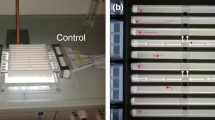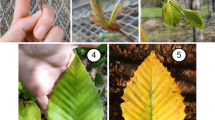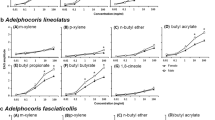Abstract
The tropical root weevil Diaprepes abbreviatus (L. 1758) (Coleoptera: Curculionidae) is a polyphagous insect from the Caribbean Islands and an invasive insect in the southern part of the United States where it is pest of citrus crops and ornamental trees. Adults feed upon foliage where aggregation, mating and oviposition take place. Here, the headspace volatiles from Citrus macrophylla Wester (Rutaceae), D. abbreviatus adults feeding on this plant, adults alone and adult feces, were collected by aeration and solid-phase microextraction (SPME) for analysis by gas chromatography-linked mass spectrometry (GC-MS). Electrophysiological responses of weevil antennal receptors to volatile headspace extracts and synthetic analogues were recorded by gas chromatography-linked electroantennographic detection (GC-EAD) and electroantennograms (EAGs). Antennal responses were recorded to the monoterpenes (R)-(−)-linalool, citronellal, nerol, citral, and geraniol; all present in the headspace of C. macrophylla. Antennal responses were also recorded to carvacrol, present in the headspace of adults and adult feces. The green leaf volatiles cis-3-hexen-1-ol and trans-2-hexen-1-ol, produced by other host plants, elicited reliable responses on the D. abbreviatus antenna. When comparing EAGs between (±)-linalool and (R)-(−)-linalool, no significant difference was found; responses to (R)-(+)-citronellal were larger than for (S)-(−)-citronellal. Among the individual compounds and blends tested using an open T-track dual choice olfactometer, only the blend of (±)-linalool, cis-3-hexen-1-ol and carvacrol (source dose 25:25:2.5 μg) elicited significant attraction of females, the same blend was repellent for males. The biologically active compounds found here likely play a role in host finding by D. abbreviatus and other interactions of the insect with its hostplant.



Similar content being viewed by others
References
Adair RC, Nigg HN, Simpson SE, Lefevre L (1998) Ovipositional preferences of Diaprepes abbreviatus (Coleoptera: Curculionidae). Fla Entomol 82:225–234. doi:10.2307/3496091
Altuzar A, Malo EA, González-Hernández H, Rojas JC (2007) Electrophysiological and behavioural responses of Scyphophorus acupunctatus (Col., Curculionidae) to Agave tequilana volatiles. J Appl Entomol 131:121–127
Anderson P, Larsson M, Löfqvist J, Hansson BS (1996) Plant odour receptor neurons on the antennae of two moths Spodoptera littoralis and Agrotis segetum. Entomol Exp Appl 80:32–34. doi:10.1007/BF00194718
Beavers JB, McGovern TP, Adler VE (1982) Diaprepes abbreviatus: laboratory and field behavioral and attractancy studies. Environ Entomol 11:436–439
Bichão H, Borg-Karlson AK, Araújo J, Mustaparta H (2005) Five types of olfactory receptor neurons in the strawberry blossom weevil Anthonomus rubi: selective responses to inducible host–plant volatiles. Chem Senses 30:153–170. doi:10.1093/chemse/bji012
Blight MM, Pickett JA, Smith MC, Wadhams LJ (1984) An aggregation pheromone of Sitona lineatus. Naturwissenschaften 71:480. doi:10.1007/BF00455905
Brase CH, Brase CP (1983) Understanding statistics. DC Health and Co., Lexington, MA
Casabianca H, Graff JB, Faugier V, Fleig F, Grenier C (1997) Enantiomeric distribution studies of linalool and linalyl acetate. A powerful tool for authenticity control of essential oils. HRC J High Res Chrom 21:107–112. doi:10.1002/(SICI)1521-4168(19980201)21:2<107::AID-JHRC107>3.0.CO;2-A
Chisholm MG, Jell JA, Cass DM Jr (2003) Characterization of the mayor odorants found in the peel oil of Citrus reticulata Blanco cv. Clementine using gas chromatography-olfactometry. Flavour Fragr J 18:275–281. doi:10.1002/ffj.1188
Dickens JC (1978) Olfactory perception of pheromone and host-odour enantiomers by Ips typographus (Coleoptera: Scolytidae). Entomol Exp Appl 24:136–142. doi:10.1007/BF02385082
Dickens JC (1984) Green leaf volatiles enhance aggregation pheromone of boll weevil, Anthonomus grandis. Entomol Exp Appl 52:191–203. doi:10.1007/BF00414044
Dickens JC (1990) Specialized receptor neurons for pheromones and host plant odors in the boll weevil, Anthonomus grandis Boh. (Coleoptera: Curculionidae). Chem Senses 15:311–331. doi:10.1093/chemse/15.3.311
Dickens JC (1999) Predator–prey interactions: olfactory adaptations of generalist and specialist predators. Agric For Entomol 1:47–54. doi:10.1046/j.1461-9563.1999.00007.x
Dickens JC (2000) Orientation of Colorado potato beetle to natural and synthetic blends of volatiles emitted by potato plants. Agric For Entomol 2:167–172. doi:10.1046/j.1461-9563.2000.00065.x
Dickens JC, Jang EB, Light DM, Alford AR (1990) Enhancement of insect pheromone responses by green leaf volatiles. Naturwissenschaften 77:29–31. doi:10.1007/BF01131792
Dickens JC, Billings RF, Payne TL (1992) Green leaf volatiles interrupt aggregation pheromone response in bark beetles infesting southern pines. Experientia 48:523–524. doi:10.1007/BF01928180
Dickens JC, Oliver JE, Hollister B, Davis JC, Klun JA (2002) Breaking the paradigm: male-produced aggregation pheromone for the Colorado potato beetle. J Exp Biol 4:309–314
Dugo P, Mondello L, Cogliandro E, Verzera A, Dugo G (1996) On the genuineness of citrus essential oils. 51. Oxygen heterocyclic compounds of bitter orange oil (Citrus aurantium L.). J Agric Food Chem 44:544–549. doi:10.1021/jf950183m
Elkinton JS, Schal C, Onot T, Cardé (2008) Pheromone puff trajectory and upwind flight of male gypsy moths in a forest. Physiol Entomol 12:399–406. doi:10.1111/j.1365-3032.1987.tb00766.x
El-Sayed AM, Suckling DM, Wearing CH, Byers JA (2006) Potential of mass trapping for long-term pest management and eradication of invasive species. J Econ Entomol 99:1550–1564
Engelberth J, Alborn HT, Schmelz EA, Tumlinson JH (2004) Airborne signals prime plants against insect herbivore attack. Proc Nat Acad Sci Wash 101:1781–1785. doi:10.1073/pnas.0308037100
Geiselhardt S, Jacobschy D, Ockenfels P, Peschke K (2008) A sex pheromone in the desert tenebrionid beetle Parastizopus armaticeps. J Chem Ecol 34:1065–1071. doi:10.1007/s10886-008-9488-1
Hansson BS, Larsson MC, Leal WS (1999) Green leaf volatile-detecting olfactory detecting receptor neurons display very high sensitivity and specificity in a scarab beetle. Physiol Entomol 24:121–126. doi:10.1046/j.1365-3032.1999.00121.x
Hansson BS, Carlsson MA, Kalinovà B (2003) Olfactory activation patterns in the antennal lobe of the sphinx moth, Manduca sexta. J Comp Physiol [A] 189:301–308
Harari AR, Landolt PJ (1997) Orientation of sugar cane rootstalk borer weevil Diaprepes abbreviatus, to weevil, frass and food odors. J Chem Ecol 23:857–868. doi:10.1023/B:JOEC.0000006416.96240.aa
Heath RR, Manukian A (1994) An automated system for use in collecting volatile chemicals released from plants. J Chem Ecol 20:593–608. doi:10.1007/BF02059600
Ihaka R, Gentleman R (1996) R: a language for data analysis and graphics. J Comput Graph Stat 5:299–314. doi:10.2307/1390807
Jaffé K, Sánchez P, Cerda H, Hernández JV, Jaffé R, Urdaneta N, Guerra G, Martínez R, Miras B (1993) Chemical ecology of the palm weevil Rhynchophorus palmarum (L.) (Coleoptera: Curculionidae): attraction to host plants and to a male-produced aggregation pheromone. J Chem Ecol 19:1703–1720. doi:10.1007/BF00982302
Jones IF, Schroeder WJ (1984) Capture of Diaprepes abbreviatus (Coleoptera: Curculionidae) in frass extract-baited traps in Citrus. J Econ Entomol 77:334–336
Jordán MJ, Margaría CA, Shaw PE, Goodner KL (2003) Volatile components and aroma active compounds in aqueous essence and fresh pink guava fruit puree (Psidium guayava L.) by GC-MS and multidimensional GC/GC-O. J Agric Food Chem 51:1421–1426. doi:10.1021/jf020765l
Lanteri AA, Guedes JC, Parra JRP (2002) Weevils injurious for roots of citrus in São Paulo state, Brazil. Neotrop Entomol 31:561–569. doi:10.1590/S1519-566X2002000400008
Lapointe SL (2004) Antecedentes y estrategias para el combate de Diaprepes abbreviatus, plaga invasora del Caribe. Manejo Integrado Plagas Agroecologia (Costa Rica) 71:106–111
Lapointe SL, Shapiro JP (1999) Effect of soil moisture on development of Diaprepes abbreviatus (Coleoptera: Curculionidae). Fla Entomol 82:291–299. doi:10.2307/3496582
Lewinshon E, Schalechet F, Wilkinson J, Matsui K, Tadmor Y, Nam K, Amar O, Lastochkin E, Larkov O, Ravid U, Hiatt W, Gepstein S, Pichersky E (2001) Enhanced levels of the aroma and flavor compound S-linalool by metabolic engineering of the terpenoid pathway in tomato fruits. Plant Physiol 127:1256–1265. doi:10.1104/pp.010293
Loudon C, Koehl MAR (2000) Sniffing by a silkworm moth: wing fanning enhances air penetration through and pheromone interception by antennae. J Exp Biol 203:2977–2990
Ma WC, Visser JH (1978) Single unit analysis of odour quality coding by the olfactory antennal receptor system of the Colorado beetle. Entomol Exp Appl 24:320–333. doi:10.1007/BF02385105
Mannion C, Hunsberger A, Peña JE, Lance O (2003) Oviposition and larval survival of Diaprepes abbreviatus (Coleoptera: Curculionidae) on select host plants. Fla Entomol 86(2):165–173. doi:10.1653/0015-4040(2003)086[0165:OALSOD]2.0.CO;2
Martorell LF (1976) Annotated food plant catalog of the insects of Puerto Rico. Agricultural Experiment Station, University of Puerto Rico
Matsui K (2006) Green leaf volatiles: hydroperoxide lyase pathway of oxylipin metabolism. Curr Opin Plant Biol 9:274–280. doi:10.1016/j.pbi.2006.03.002
Marvaldi AE (1998) Larvae of Entiminae (Coleoptera:Curculionidae): tribal diagnoses and phylogenetic key, with proposal about natural groups within Entimini. Ent Scand 29:89–98
McCoy CW, Rogers ME, Futch SH, Graham JH, Duncan LW, Nigg HN (2005) 2006 Florida citrus pest management guide: citrus root weevils. IFAS. University of Florida, ENY 611:5
Naef R, Jaquier A (2006) New aldehydes and related alcohols in fresh lemon peel extract (Citrus limon L.). Flavour Fragr J 21:768–771. doi:10.1002/ffj.1678
Otálora-Luna F, Perret JL, Guerin PM (2004) Appetence behaviours of the triatomine bug Rhodnius prolixus on a servosphere in response to the host metabolites carbon dioxide and ammonia. J Comp Physiol [A] 190:847–854. doi:10.1007/s00359-004-0540-5
Paré PW, Tumlinson JH (1997) De novo biosynthesis of volatiles induced by insect herbivory in cotton plants. Plant Physiol 114:1161–1167
Paré PW, Tumlinson JH (1999) Plant volatiles as a defense against insect herbivores. Plant Physiol 121:325–331. doi:10.1104/pp.121.2.325
Raguso RA, Pichersky E (1999) A day in the life of a linalool molecule: chemical communication in a plant-pollinator system. Part 1: linalool biosynthesis in flowering plants. Plant Species Biol 14:95–120. doi:10.1046/j.1442-1984.1999.00014.x
Reddy GVP, Cruz ZT, Bamba J, Muniappan R (2005) Development of a semiochemical-based trapping method for the New Guinea sugarcane weevil, Rhabdoscelus obscurus in Guam. J Appl Entomol 129:65–69. doi:10.1111/j.1439-0418.2005.00935.x
Scora RW, Kumamoto J, Clerx WA (1981) Variations of leaf oil composition of citrus budded on different rootstocks. Syst Bot 6:31–37. doi:10.2307/2418633
Selli S, Cabaroglu T, Canbas A (2004) Volatile flavour components of orange juice obtained from the cv. Kozan of Turkey. J Food Compos Anal 17:789–796
Shulaev V, Silverman P, Raskin I (1997) Airborne signaling by methyl salicylate in plant pathogen resistance. Nature 384:718–721. doi:10.1038/385718a0
Simpson SE, Nigg HN, Coilen NC, Adair RA (1996) Diaprepes abbreviatus (Coleoptera: Curculionidae): host plant associations. Environ Entomol 25:333–349
Sokal RR, Rohlf FJ (1995) Biometry, 3rd edn. Freeman, New York, 887 pp
Song HS, Sawamura M, Ito T, Kawashimo K, Ukeda H (2000) Quantitative determination and characteristic flavour of Citrus junos (yuzu) peel oil. Flavour Fragr J 15:245–250. doi:10.1002/1099-1026(200007/08)15:4<245::AID-FFJ904>3.0.CO;2-V
Tobin TR, Bell WJ (1986) Chemo-orientation of male Trogoderma variabile (Coleoptera, Dermestidae) in simulated corridor of female sex pheromone. J Comp Physiol A 158:729–739. doi:10.1007/BF00603831
van Tol RWHM, Visser JH (2002) Olfactory antennal responses of the vine weevil Otiorhynchus sulcatus to plant volatiles. Entomol Exp Appl 102:49–64. doi:10.1023/A:1015243018643
Visser JH (1986) Host odor perception in phytophagous insects. Annu Rev Entomol 31:124–144. doi:10.1146/annurev.en.31.010186.001005
Visser JH, Piron PGM (1998) An open Y-track olfactometer for recording of aphid behavioral responses to plant odours. Exp Appl Entomol 9:41–46
Woodruff RE (1985) Citrus weevils in Florida and the West Indies: preliminary report on systematics, biology, and distribution (Coleoptera: Curculionidae). Fla Entomol 68:370–379. doi:10.2307/3495121
Yajima I, Yanai T, Nakamura M, Sakakibara H, Hayashi K (1979) Composition of the volatiles of peel oil and juice from Citrus unshiu. Agric Biol Chem 43:259–264
Acknowledgments
We thank Drs. Meiling Webb and John C. Davis for technical assistance (USDA, Beltsville, MD), Anna Hill (USDA, Ft. Pierce, FL) for rearing the insects and shipping them with foliage to Beltsville and Andrea Hernández V. for comments on D. abbreviatus behavior.
Author information
Authors and Affiliations
Corresponding author
Additional information
Handling editor: Sam Cook
Rights and permissions
About this article
Cite this article
Otálora-Luna, F., Hammock, J.A., Alessandro, R.T. et al. Discovery and characterization of chemical signals for citrus root weevil, Diaprepes abbreviatus . Arthropod-Plant Interactions 3, 63–73 (2009). https://doi.org/10.1007/s11829-009-9058-7
Received:
Accepted:
Published:
Issue Date:
DOI: https://doi.org/10.1007/s11829-009-9058-7




